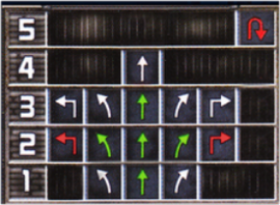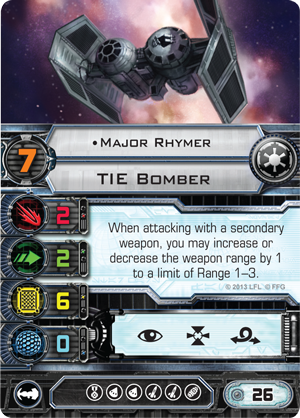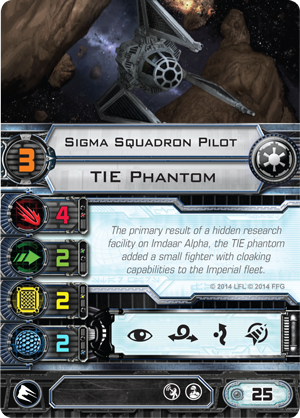In my last article I kicked things off by looking at the Nebulon B and sort of doing a thorough assessment of a single ship. Now part of the reason I did this is because, in as a whole I feel in order to become a good Armada player you really need to look deeply under the hood of every ship, every upgrade, every mechanic etc. in the game. Hopefully that article presented a sufficiently thorough investigation into one ship that might trigger readers to look at others with the same vigor.
My next article in the series I attribute to the relentless ass whooping’s I have received since I started player Armada. Despite all the frustration, confusion and failed attempts at becoming a good Armada player what I have found is that from failure comes the greatest gains. In today’s article we are going to look at some of those lessons. Some of it will be very specific, some very theoretical but for me its all-golden lessons learned through the very gratifying art of utter failure.
Don’t forget to assess your opponents list
This really is one of the most common reasons why I have lost games. I get to the table, excited, full of energy, I just want to get those ships on the table and start the epic strategy I have contrived after days of staring and thinking about my own list. In the end however no matter how you analyze your own list, the reality is that you are not going to win because of your list, you are going to lose because of your opponents.

Knowing what your opponents list strategy is, what his individual ships can do, what combo’s and synergy he has and how that affects your list is absolutely vital to know long before you start setting down ships. You have to take the time to look, asses, think and adapt to your opponents list. This tip alone as seemingly obvious as it is, is actually almost never done. Even in tournaments it’s rare for my opponent to even ask me what I have, let alone actually come around the table and take a moment to look. Doing this improves your chances of winning dramatically, don’t ever forget!
Accept the Meta, Embrace The Imbalance
Meta’s always form, whether it’s the general competitive tournament meta, your local game shop or group meta or just casual games between you and your one friend. You have to adapt to the formation of metas and simply accept that in most cases meta’s are formed out of imbalanced elements of the game or more typically perceived imbalances. Players are going to try to find the best, most effective ways to win matches and the foundation of that is always going to be based on select elements of the game due to their efficiency and impact. In a sense this creates exclusion of many components of the game, while creating a sort of automatic selection of others. Not always a terribly fun approach to a game, but ignoring it is really is shooting yourself in the foot. Besides, meta’s change over time and it’s in this constant adjustment where the best players thrive, to be one, so must you.

It’s more than just understanding the meta though, its actively building lists and preparing yourself to respond to it. It’s really easy to throw your hands up in the air and proclaim something OP, but the purity and joy of overcoming a challenge by cleverly built lists and executed strategies is a feeling like no other. Challenge yourself to unravel the puzzles the meta presents and find solutions to overcoming it. Not only will you become a superior player but you are going to distinguish yourself because very few people get too far beyond filing complaints on the forums where their tears are collected by better players. If you must bitch, do so among the company of better players who if you are lucky will pat you on the back, offer advice and inspire you to try again.
Squads are vital, Don’t Ignore them
While I think there will always be effective ways to build all sorts of interesting and unique lists that exclude fighter squadrons, I believe they are really a core element of the Armada mechanic at this point. The game is really centered around the assumption that you will have fighters and the way fighter squadrons affect the game is in essence a sort of secondary battle which when resolved will allow the victor to push through to the heart of the main battle quickly turning the tide. In every match of Star Wars Armada I have ever played, in the end, when I asses the game I always come to the same conclusion. Fighter squadrons Impact and contribution is as vital as any capital ship. I have never played a game where squadrons didn’t play a key role in the victory of a game or the minimizing of a loss. Ignore them at your own peril but if you take any wisdom from this article, know that squadrons are like an insurance policy. You might not always need them, but not having them when you do is usually quite devastating.

It’s a game of maneuvering, not dice
Oh this is so hard to admit and so difficult to accept, especially for an unlucky bastard like me. It never fails that you pick up a handful of dice, watching the look on your opponent as he awaits his inevitable fate only to find heart ache on the table. The dice gods are cruel and we curse them for their insolence.
Yes, dice do matter but if you end a match and blame the dice for your loss you will never, ever, be a good Armada player. Oh it’s hard, I know, believe me, if anyone has a complaint to file with the dice gods it’s me. In the end however no matter how you analyze, no matter how much you calculate and how much time you spend in church praying, its maneuvering not dice that will lead you to victory.

This is first and foremost a game of maneuvering and it’s a rare match indeed that you can’t trace back to tactical maneuvering errors. Sure builds are important, global strategies are important and certainly if you are just rolling blanks things aren’t going to go well. Maneuvering however is the great equalizer, it’s how you deny your opponent opportunities and create them for yourself. There is no better method to improve your game than learning to control the plastic on the table. Getting those ships into their arches, managing ranges, precision timing and the ability to think a turn or two ahead are all priceless skills.
More than that though as you learn to maneuver and become efficient at being exactly where you want to be, it opens doorways to new builds, to understanding advantages of less common ships and equipment and above all else it allows you the luxury of creating more efficiency within your lists as you won’t have to compensate for your own errors.
No question in my mind that if you learn to do nothing else but maneuvering like a pro you WILL win games.
Don’t give up
I’m not referring to Armada in general but specifically matches that have gone badly or turned on you. I have found that in Armada it’s not over until the fat lady sings and while sometimes you can have atrocious setbacks, every new round offers an opportunity for your opponent to make a mistake and you to make a comeback.
I have seen opponents rise from the grave and I have watched my self fall from seemingly impossible heights. If you stick it out, re-asses and continue to look for opportunities you stand a solid chance of finding them and making a comeback and this isn’t just some motivational or inspirational suggestion, it’s an object fact in Star Wars Armada for mechanical reasons.
It’s difficult to explain, I will do my best here. The thing about Armada is that setbacks usually take place for one of two reasons, your opponent executes a well laid plan and it worked, or you made a mistake and gave him an opportunity that he ceased. The thing about Armada is that everything always has a drawback, regardless of how the success was given birth. There is no action you can take that won’t ultimately present consequences for taking it and at its core this is why Armada is so mechanically well balanced.
Whatever advantage a ship has in one round, will be undone because he took that action in the next and this is the part you have to see on the board to understand how you will take advantage of it and turn things around. Every ship in particular has an optimal position that they are trying to get themselves in but ultimately that position will become a liability in future rounds when it has passed. Sure that Demolisher can shoot, move and shoot which can have deadly results for you, but he has to move and that position he is in when the smoke clears, is your new advantage, cease it.
Point here is that everyone eventually has to expose their weakness but it can be hard to see through the tears of a previous disaster, you have to wipe them away and look for the opportunities that result, they are probably staring you right in the face.
Strategy and Planning around the dice
Ok so I already said the game is not about the dice so this may sound contradictory but you do in fact have to have some sort of plan on how to handle dice because they are part of the game. You have to understand the threats and opportunities on the table and those are often represented by the potential of the dice. Here is how I see them.
First and foremost the black and blue dice you have to see as guaranteed hits, meaning when you are planning your strategy just presume whatever amounts of dice are being rolled, that is how many hits you can expect out of blue and black. This is a very statistically inaccurate way to look at it, but if you walk into a match with this belief and you make decisions based on that assumption you are going to be a lot tougher to beat.
Never roll red die at medium or short range, if you do, you’re doing it wrong. Ok again, hardly a realistic assessment, or even realistically possible to do but it’s how you want to see the use of your ships that are focused on red dice. Your job is to play keep away, you want to roll red dice without getting blue or black dice thrown at you from your targets. Clearly an impossible task but again if you approach the game with this attitude you will be a lot tougher to beat.
Always work on the assumption that your opponent will roll better than you. This is my favorite piece of advice because it mentally prepares you for what the game typically feels like even though statistically it’s probably not true. Aggression can and often will be rewarded, but reliance on out rolling your opponent NEVER pays in anyway shape or form. The game is about strategy, not gambling on your ability to roll dice well and don’t trick yourself into calling it “risk”. It’s not risk if you’re praying for good results for yourself and bad results for your opponent. Again, it’s a game about maneuvering so your job is to deny your opponent opportunities first and create them for yourself second. If you create opportunities for yourself while setting up your opponent for his you aren’t creating a strategy, you are worshiping at the altar of luck. Trust me, it’s worse than scientology, it’s a path that leads nowhere.
Finally don’t build lists driven by statistical dice assumptions or explosive possibilities. For example a Salvation with Slaved Turrets and a concentrate fire lets you roll 5 dice. That’s fantastic, but if the only reason you added that ship to your list is because you might get 5 double hit results for a staggering 10 damage be prepared to be disappointed. Don’t build strategies based on rolling dice because dice will disappoint you. Build strategies on consistency, reliability or as part of a larger tactical plan. For example the Salvation might be perfect if combined to be part of a larger strategy in which the reliance is less so on the dice but on the tactical maneuverability and advantage of the Nebulon-B. Rolling 5 dice and getting 10 hits, great!!— if you get them, but if you don’t, your strategy shouldn’t suddenly fall apart as a result.

The Golden Rule
Ok this is a bit cliché but don’t forget that it’s a game and you are there to have fun. Competitive or casual it makes no difference, if you don’t like the list your running or the strategy you have built you aren’t going to win no matter how well thought out it is if all your trying to do is just get it done so that it’s over. The best players are always the most enthusiastic ones; those that love the game and want to be there win or lose. All and all victory is sweet, but it can leave you bitter if you didn’t enjoy earning it!
I have to admit that I don’t always take my own advice but I’m never surprised to find myself losing a match, then going back and making the stark realization that if I had, I probably would have done a lot better. Still I really believe in the advice presented here, I honestly think that if you follow it you will win more often and enjoy the game a lot more.
Have a great weekend, Nerd out!














 Torpedo’s were effectively the first ordinance introduced into X-Wing in the original core set. Torpedoes typically require you to spend your target lock, so they put you in a position where you might be rolling dice without a focus token which is typically bad. It’s especially bad for one shot items that cost between 2 to 6 points. When it comes to torpedoes as ordinance you are pretty much always looking to create synergy effects to help ensure that when you shoot you get your points worth in damage caused. This is why early ships like Garven Dreis and Dutch Vander where such a great combo for using torpedoes. The question is are they worth it, well, yeah, I think they are.
Torpedo’s were effectively the first ordinance introduced into X-Wing in the original core set. Torpedoes typically require you to spend your target lock, so they put you in a position where you might be rolling dice without a focus token which is typically bad. It’s especially bad for one shot items that cost between 2 to 6 points. When it comes to torpedoes as ordinance you are pretty much always looking to create synergy effects to help ensure that when you shoot you get your points worth in damage caused. This is why early ships like Garven Dreis and Dutch Vander where such a great combo for using torpedoes. The question is are they worth it, well, yeah, I think they are.
















You must be logged in to post a comment.